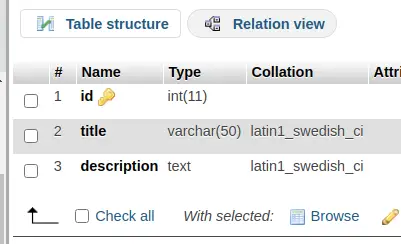Inside this article we will see the concept of CakePHP 4 Query Builder CRUD functions. In this we will cover Insert, Update, Select, Delete functions of CakePHP ORM’s Builder. Article contains classified information about the concept.
CakePHP 4 provides several ways to run database queries like ORM Query Builder, By using ConnectionManager Instance, By Model & Entity. In this we will cover Query Builder methods.
CRUD means Create, Read, Update & Delete. In this we will discuss all methods of ORM to perform a complete set of crud functions.
Learn More –
- CakePHP 4 Get Single Row Data From Database Tutorial
- CakePHP 4 Google Bar Chart Integration Tutorial
- CakePHP 4 Google Line Chart Integration Tutorial
- CakePHP 4 Google Pie Chart Integration Tutorial
Let’s get started.
CakePHP 4 Installation
To create a CakePHP project, run this command into your shell or terminal. Make sure composer should be installed in your system.
$ composer create-project --prefer-dist cakephp/app:~4.0 mycakephp
Above command will creates a project with the name called mycakephp.
Create Database
To create a database, either we can create via Manual tool of PhpMyadmin or by means of a mysql command.
CREATE DATABASE mydatabase;Successfully, we have created a database.
Database Connection
Open app_local.php file from /config folder. Search for Datasources. Go to default array of it.
You can add your connection details here to connect with your database. It will be like this –
//...
'Datasources' => [
'default' => [
'host' => 'localhost',
/*
* CakePHP will use the default DB port based on the driver selected
* MySQL on MAMP uses port 8889, MAMP users will want to uncomment
* the following line and set the port accordingly
*/
//'port' => 'non_standard_port_number',
'username' => 'root',
'password' => 'sample@123',
'database' => 'mydatabase',
/*
* If not using the default 'public' schema with the PostgreSQL driver
* set it here.
*/
//'schema' => 'myapp',
/*
* You can use a DSN string to set the entire configuration
*/
'url' => env('DATABASE_URL', null),
],
//...
//...
You can pass host, username, password and database.
Successfully, you are now connected with the database.
Create Migration
Open project into terminal and run this commands to create migration file.
$ bin/cake bake migration CreateBlogsIt will create 20220330143909_CreateBlogs.php file inside /config/Migrations folder.
Open migration file and write this following code into it. The code is all about for the schema of blogs table.
<?php
declare(strict_types=1);
use Migrations\AbstractMigration;
class CreateBlogs extends AbstractMigration
{
public function change()
{
$table = $this->table('blogs');
$table->addColumn("title", "string", [
"limit" => 50,
"null" => false
]);
$table->addColumn("description", "text", [
"null" => false
]);
$table->create();
}
}
Run Migration
Back to terminal and run this command.
$ bin/cake migrations migrateIt will create table “blogs” inside database.

Create Table Locator Class
Here, we need to create table class. Model is termed as table class. For blogs table we should BlogsTable.php class.
Let’s create it.
We will create model and entity. Back to terminal and run this command.
$ bin/cake bake model Blogs --no-validation --no-rulesIt will create model file BlogsTable.php inside /src/Model/Table folder. Also we should see the entity file Blog.php inside /src/Model/Entity folder.
Create Controller
Open project into terminal and run this command into it.
$ bin/cake bake controller Site --no-actionsIt will create SiteController.php file inside /src/Controller folder. Open controller file and write this code into it.
<?php
declare(strict_types=1);
namespace App\Controller;
class SiteController extends AppController
{
private $blogObject;
public function initialize(): void
{
parent::initialize();
$this->autoRender = false;
$this->blogObject = $this->getTableLocator()->get('Blogs'); // Loading Table Class
}
// Get all blogs
public function getAllBlogs()
{
$query = $this->blogObject->find();
$blogs = $query->all();
foreach ($blogs as $article) {
echo $article->title;
}
}
// Get single blog data
public function singleBlogData()
{
$blog_id = 5;
$query = $this->blogObject->find()->where(['id' => $blog_id]);
$singleBlog = $query->first();
print_r($singleBlog);
}
// Insert Blog
public function insertBlog()
{
$query = $this->blogObject->query();
$query->insert(['title', 'description'])
->values([
'title' => 'First post',
'description' => 'Some body text'
])
->execute();
}
// Update Blog
public function updateBlog()
{
$query = $this->blogObject->query();
$blog_id = 5;
$query->update()
->set(['title' => "Updated value"])
->where(['id' => $blog_id])
->execute();
}
// Delete blog
public function deleteBlog()
{
$query = $this->blogObject->query();
$blog_id = 5;
$query->delete()
->where(['id' => $blog_id])
->execute();
}
}
Above controller class contains all methods for CRUD operations like of Insert, Update, Delete, Select etc.
Disable CSRF Token
When we submit a cakephp form, it needs a CSRF token should be submitted with form submission request.
We are not interested to send CSRF token with form data. To disable it, Open Application.php from /src folder.
Remove these lines of code from middleware() method.
->add(new CsrfProtectionMiddleware([
'httponly' => true,
]))Add Route
Open routes.php file from /config folder. Add these routes into it.
//...
$routes->connect(
'/insert-blog',
['controller' => 'Site', 'action' => 'insertBlog']
);
$routes->connect(
'/update-blog',
['controller' => 'Site', 'action' => 'updateBlog']
);
$routes->connect(
'/all-blogs',
['controller' => 'Site', 'action' => 'getAllBlogs']
);
$routes->connect(
'/single-blog',
['controller' => 'Site', 'action' => 'singleBlogData']
);
$routes->connect(
'/delete-blog',
['controller' => 'Site', 'action' => 'deleteBlog']
);
//...Application Testing
Open terminal and run this command to start development server.
$ bin/cake serverCRUD URL’s
- Create Blog: http://localhost:8765/insert-blog
- Update Blog: http://localhost:8765/update-blog (You can specify your dynamic Blog ID)
- Delete Blog: http://localhost:8765/delete-blog (You can specify your dynamic Blog ID)
- All Blogs: http://localhost:8765/all-blogs
- Single Blog: http://localhost:8765/single-blog (You can specify your dynamic Blog ID)
We hope this article helped you to learn about CakePHP 4 Query Builder CRUD Functions Tutorial in a very detailed way.
Online Web Tutor invites you to try Skillshike! Learn CakePHP, Laravel, CodeIgniter, Node Js, MySQL, Authentication, RESTful Web Services, etc into a depth level. Master the Coding Skills to Become an Expert in PHP Web Development. So, Search your favourite course and enroll now.
If you liked this article, then please subscribe to our YouTube Channel for PHP & it’s framework, WordPress, Node Js video tutorials. You can also find us on Twitter and Facebook.
